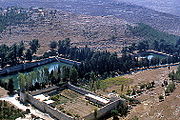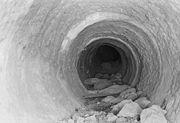
Solomon's Pools
Encyclopedia


Al-Khader
Al-Khader is a Palestinian town in the Bethlehem Governorate in the south-central West Bank. It is located west of Bethlehem. According to the Palestinian Central Bureau of Statistics, the town had a population of 9,774 in 2007.-History:...
and about 5 kilometres southwest of Bethlehem
Bethlehem
Bethlehem is a Palestinian city in the central West Bank of the Jordan River, near Israel and approximately south of Jerusalem, with a population of about 30,000 people. It is the capital of the Bethlehem Governorate of the Palestinian National Authority and a hub of Palestinian culture and tourism...
. The pools consist of three open cisterns
Cistern
A cistern is a waterproof receptacle for holding liquids, usually water. Cisterns are often built to catch and store rainwater. Cisterns are distinguished from wells by their waterproof linings...
, each pool with a 6 metre drop to the next, fed from an underground spring. With each pool being over 100 metres long, 65 metres wide and 10 metres deep, the total water capacity is approximately 200 million litres. Consequently the pools have played a significant role in the area's water supply for centuries. They are erroneously named after the Biblical Solomon
Solomon
Solomon , according to the Book of Kings and the Book of Chronicles, a King of Israel and according to the Talmud one of the 48 prophets, is identified as the son of David, also called Jedidiah in 2 Samuel 12:25, and is described as the third king of the United Monarchy, and the final king before...
, stemming from a legend of Solomon using the waters and gardens as in Ecclesiastes 2.6, where Solomon is recorded as saying "I made myself pools from which to water the forest of growing trees".
However, recent evidence suggests that the lowest pool was probably the constructed during the Maccabean period at the time of the reconstruction of the temple at Jerusalem (circa 2 BCE). A second phase occurred when Pontius Pilate built 39 km of aqueduct from the collection pools at Arrub
Al-Arroub (camp)
al-Arroub is a Palestinian refugee camp located in the southern West Bank along the Hebron-Jerusalem road in the Hebron Governorate. It is fifteen kilometers south of Bethlehem. The camp's total land area is 350 dunums and according to the UNRWA, in 2005, it had a population of 9,859 registered...
. Roman engineering under Herod the Great
Herod the Great
Herod , also known as Herod the Great , was a Roman client king of Judea. His epithet of "the Great" is widely disputed as he is described as "a madman who murdered his own family and a great many rabbis." He is also known for his colossal building projects in Jerusalem and elsewhere, including his...
in connection with his improvements to the Second Temple
Second Temple
The Jewish Second Temple was an important shrine which stood on the Temple Mount in Jerusalem between 516 BCE and 70 CE. It replaced the First Temple which was destroyed in 586 BCE, when the Jewish nation was exiled to Babylon...
created the underground tunnel feeding the upper pool.
The pools provide water for an aqueduct system supplying Bethlehem and for the population of Jerusalem where the aqueduct terminated under the Temple Mount
Temple Mount
The Temple Mount, known in Hebrew as , and in Arabic as the Haram Ash-Sharif , is one of the most important religious sites in the Old City of Jerusalem. It has been used as a religious site for thousands of years...
and separated from its neighbour by 50 metres and each pool is 6 metres lower than that above it, the conduits being so arranged that the lowest, which is the largest and finest of the three, is filled first, and then in succession the others. It has been estimated that these pools cover about 7 acres (28,328 m²).
The pools are fed by four different springs; the most prominent is Ein-Atan or Etam at the head of the Wadi Urtas, called "the sealed fountain," about 200 metres to the north-west of the upper pool. The spring water is transferred to the upper pool by a large subterranean passage. The water system as a whole shows a high degree of sophistication. Five different aqueducts, totalling nearly 60 kilometres in length, were linked to Solomon's Pools. From the lower pool an aqueduct has been traced carrying the water through Bethlehem and across the valley of Gihon, and along the west slope of the Tyropoeon valley, till it finds its way into the great cisterns underneath the temple hill in Jerusalem. The water, however, from the pools now reaches only to Bethlehem. The aqueduct beyond this has been destroyed. Two of the aqueducts connected to additional water sources from the south; another, from the upper pool, carried water east to the Herodium
Herodium
Herodium or Herodion is a volcano-like hill with a truncated cone located south of Jerusalem, near the city of Bethlehem in the West Bank. Herod the Great built a fortress and palace on the top of Herodium, and may have been buried there...
where Herod had constructed a large recreational pool, lined with columns; and two aqueducts brought water to Jerusalem.
The area around Solomon's Pools has provided a pleasant atmosphere for picnics and relaxation over the centuries. On the north side at the entry to the park is an old Ottoman
Ottoman Empire
The Ottoman EmpireIt was usually referred to as the "Ottoman Empire", the "Turkish Empire", the "Ottoman Caliphate" or more commonly "Turkey" by its contemporaries...
structure, built in 1620, which is known as Qal'at el-Burak or the castle of the pools. This has served at times as a khan
Caravanserai
A caravanserai, or khan, also known as caravansary, caravansera, or caravansara in English was a roadside inn where travelers could rest and recover from the day's journey...
(a resting place for caravans) and now has a restaurant with a garden area inside.
External links
- Solomon's Pool, from PalestineFamily.net

